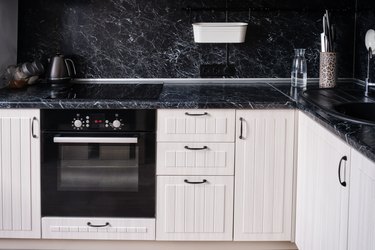
Convection ovens are fantastic, but the new owner will find them a departure from traditional ovens. When it comes to your motivation in troubleshooting your GE Profile microwave convection oven, you may be attempting to resolve displayed error codes or the oven may be doing things that seem odd to you. Either way, here are some problems and codes that may help you figure things out.
GE Profile Convection Oven: Errors
Video of the Day
This is a good time to dig out your GE convection oven instructions or owner's manual, as there's a lot of helpful known issues and troubleshooting advice in them. But here are a few common errors you might see:
Video of the Day
- Control Panel Issues: Error Codes F0, F1, F7
This means a keypad button is stuck or defective — but it can also signal the need to replace the control board entirely. To find out, press the clear/off button, turn the oven power off, then disconnect control board's ribbon-style connection and turn the power back on. If the code comes back within about a minute, the board needs replacing.
- Overheating Issue: Error Code F2
This can be caused by something like the oven overheating, especially with self-cleaning models; self-cleaning mode gets so hot for so long that it's a frequent cause for control panels melting or getting damaged. The problem is so rampant that some techs advise against using self-cleaning after the warranty has expired. This can also be due to a malfunctioning temperature sensor, and the only way to find out if that's the case is to use an ohmmeter to test the resistance on the temperature sensor, which should be 1,000 ohms at 72 degrees Fahrenheit. If it's not 1,000 ohms, you'll need a new sensor.
- Temperature Sensor Problem: Error Code F3 or F4
This can mean faulty wire harness, damaged sensor or a glitching control board. Disconnect the oven power and use an ohmmeter to test the oven temperature sensor; it should read 1,080 ohms at 70 degrees F. If there's a different reading, before you go replacing the sensor, check the sensor's wire harness. If you see physical damage, then this is the first thing to try replacing, as it'll be cheaper.
- Door Lock Malfunction: Error Code FC
The oven door lock may not be working properly, but it could also be an electrical issue with the wire harness or control board. Disconnect your power supply and look to see if any wires are unconnected or damaged in the door lock circuit. Check the door lock harness too. If the harness looks damaged, this can be replaced on its own. If the harness looks fine, then you may need to install a whole new door lock assembly.
Other Weird Behaviors
Yes, your oven should click a bit. That's a normal sound as the appliance heats to the set temperature. An older oven will do more of this. Models like the GE Precise Air Convection System have such exact controls to maintain the oven temperature that you'll hear more clicks as it operates as well. Your convection fan will cycle on and off at different intervals between the preheat and cooking phases.
These, and other answers to oven-related questions, can all be found on GE's website, where they have a Frequently Asked Section for their ranges and ovens.
Beware of Self-Cleaning
Self-cleaning modes are notorious for causing malfunctions because electrical circuitry is heat sensitive. If you recently ran a self-cleaning mode and have had malfunctions or strange behaviors since, you could have issues with the electrical workings that will require a service call and parts replaced.